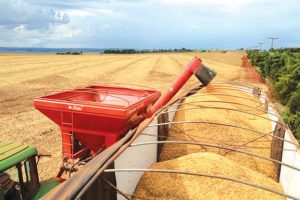Bloomberg
Soybean buyers stung by a smaller and slower harvest than expected in Brazil are turning to the US for supply, driving up prices and threatening to worsen food inflation.
What was expected to be a record crop in Brazil is now looking far smaller, with lower yields and harvest delays due to adverse weather catching traders and end-users shorthanded. The uncertainty has driven buyers into the US market. More than 110 ships have been chartered on a preliminary basis to load crops at ports in the Pacific Northwest, according to Bill Tierney, chief economist for AgResource Co. in Chicago.
The rush by physical traders and financial players has driven up futures in Chicago by 30% since early November to an eight-month high, with the premium for July contracts over November surging eight-fold. Demand for immediate delivery has pushed cash prices at elevators in the US Midwest to unusually high premiums to futures. Sales for export jumped to almost 2 million tons last week, exceeding the highest analyst estimate.
The impact of higher soybean costs is set to ripple through the food supply chain at a time when global prices are near a record. It will be more expensive to feed animals, as beans are crushed into meal for livestock and chicken. It also threatens to drive up the cost of cooking oil, already boosted by record palm and canola oil.
“South America’s soybean losses put a great responsibility on the US, where plantings and yields will need to increase to avoid†persistent high prices, Etore Baroni, an analyst at StoneX in Brazil, said at a webinar.
It wasn’t supposed to be like this. Chinese firms and other buyers typically look to South America for supply in the first quarter of the year, as the harvest typically begins in early January, with new-crop beans reaching ports weeks later. And a few months ago, all signs were for a bumper crop — some 145 million tons in Brazil, 50 million from Argentina and 10 million in Paraguay.
Planting went well within the ideal window. But then La Nina — bringing high temperatures and drought to key growing regions of southern Brazil and Argentina — has damaged the crop, and dry periods are likely to be still ahead of us, according to the weather forecaster Maxar.
 The Gulf Time Newspaper One of the finest business newspapers in the UAE brought to you by our professional writers and editors.
The Gulf Time Newspaper One of the finest business newspapers in the UAE brought to you by our professional writers and editors.
